AQA GCSE Biology Paper 2
1/294
Earn XP
Description and Tags
This set should (hopefully) contain everything you need to know for AQA GCSE Biology Paper 2. Made using the specification and Freesciencelessons on YouTube. This is designed to be used in Term → Definition mode. You can do it the other way around for extra revision, but it will not be framed as a question. Topic 5 - Homeostasis and response: Cards 1-10 Topic 6 - Inheritance, variation and evolution: Cards 102-212 Topic 7 - Ecology: Cards 213-295 (Topics 1-4 are in the Paper 1 flashcards) Note: The structure and functioning of cells, mitosis and meiosis, sexual and asexual reproduction, photosynthesis and respiration, metabolism and how materials are cycled can be assessed on either paper. Cards starting with ᵀ are triple/separate/biology only. Cards starting with ᴴ are Higher tier only. (Cards starting with ᵀᴴ are both.) If you want to remove these cards, star all the other cards and then study with starred cards only. Note: The description of the theory of evolution by natural selection in the Evolution section of the specification (4.6.2.2) is quite basic, but it says “Students should be able to explain how evolution occurs through natural selection of variants that give rise to phenotypes best suited to their environment,” so I included the description from the Theory of evolution (biology only) section (4.6.3.1) because it seems to me that that is needed to fulfil that requirement. However, that section is triple/separate/biology only. If you just want the strictly combined only section, just learn the first paragraph of the flashcard.
Biology
Evolution
GCSE Biology
AQA
aqa
gcse
biology
paper 2
higher
foundation
triple
separate
combined
trilogy
required practical
homeostasis and response
inheritance, variation and evolution
ecology
homeostasis
the human nervous system
structure and function
the brain
the eye
control of body temperature
hormonal coordination in humans
human endocrine system
control of blood glucose concentration
maintaining water and nitrogen balance in the body
hormones in human reproduction
contraception
the use of hormones to treat infertility
negative feedback
plant hormones
control and coordination
use of plant hormones
reproduction
sexual and asexual reproduction
meiosis
advantages and disadvantages of sexual and asexual reproduction
DNA and the genome
DNA structure
genetic inheritance
inherited disorders
sex determination
variation and evolution
variation
evolution
selective breeding
genetic engineering
cloning
the development of understanding of genetics and evolution
theory of evolution
speciation
the understanding of genetics
evidence for evolution
fossils
extinction
resistant bacteria
classification of living organisms
adaptations, interdependence and competition
communities
abiotic factors
biotic factors
adaptations
organisation of an ecosystem
levels of organisation
how materials are cycled
decomposition
impact of environmental change
biodiversity and the effect of human interaction on ecosystems
biodiversity
waste management
land use
deforestation
global warming
maintaining biodiversity
trophic levels in an ecosystem
trophic levels
pyramids of biomass
transfer of biomass
food production
factors affecting food security
farming techniques
sustainable fisheries
role of biotechnology
topic 5
topic 6
topic 7
science
biology only
HT
Name | Mastery | Learn | Test | Matching | Spaced |
|---|
No study sessions yet.
295 Terms
What is homeostasis?
The regulation of the internal conditions of a cell or organism to maintain optimum conditions for function, in response to internal and external changes
What does homeostasis maintain optimum conditions for?
Enzyme action and all cell functions
What types of responses may automatic control systems include?
Nervous responses or chemical responses
What do all control systems include?
Cells called receptors, which detect stimuli (changes in the environment)
Coordination centres (such as the brain, spinal cord and pancreas) that receive and process information from receptors
Effectors, muscles or glands, which bring about responses which restore optimum levels.
What does the nervous system enable humans to do?
React to their surroundings and coordinate their behaviour
Describe the human nervous system.
Information from receptors passes along cells (neurones) as electrical impulses to the central nervous system (CNS). The CNS is the brain and spinal cord. The CNS coordinates the response of effectors which may be muscles contracting or glands secreting hormones.
Describe the human reflex arc.
First, the stimulus is detected by a receptor. Electrical impulses now pass from the receptor along a sensory neurone to the central nervous system. At the end of the sensory neurone is a junction called a synapse. At the synapse, a chemical is released. This chemical now diffuses across to a relay neurone in the central nervous system, where it triggers an electrical impulse. The electrical impulse now passes across the relay neurone and reaches another synapse. Once again a chemical is released. This chemical triggers an electrical impulse in a motor neurone. The electrical impulse now passes down the motor neurone to an effector. The effector carries out the response.
Why are reflex actions important?
Reflex actions are automatic and rapid; they do not involve the conscious part of the brain. This helps to protect us from danger.
Describe how to measure someone's reaction time.
Person 1 sits on a stool with good upright posture.
Person 1 places the forearm of their dominant arm across the table, with their hand overhanging the edge.
Person 2 holds a ruler vertically. The 0cm mark should be between Person 1's thumb and first finger.
Person 2 tells Person 1 to prepare to catch the ruler.
Person 2 drops the ruler at a random time. Person 1 has to catch the ruler with their thumb and first finger as quickly as possible when it drops.
Person 2 records the measurement on the ruler that is level with the top of Person 1's thumb.
Person 1 has a short rest.
Repeat the test several times and calculate a mean.
Convert the results to a reaction time using a conversion table.
ᵀ What does the brain do?
Controls complex behaviour
ᵀ What is the brain made of?
The brain is made of billions of interconnected neurones. It has different regions that carry out different functions.
ᵀ Where in the brain is the cerebral cortex?
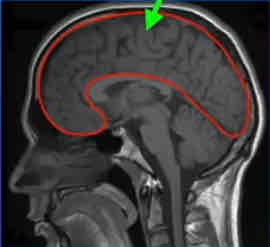
ᵀ What is the function of the cerebral cortex?
Language, memory and consciousness
ᵀ Where in the brain is the cerebellum?
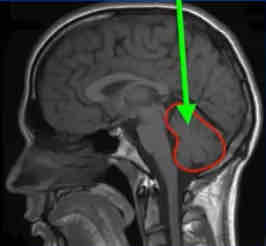
ᵀ What is the function of the cerebellum?
Controls balance and coordinates movements
ᵀ Where in the brain is the medulla?
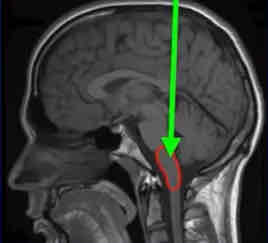
ᵀ What is the function of the medulla?
Controls heart rate and breathing rate
ᵀᴴ What are the difficulties of investigating brain function and treating brain damage and disease?
The brain is protected by the skull, so it is very tricky to access.
The structures of the brain are extremely complex, so it is difficult to work out exactly which parts of the brain carry out specific functions.
The brain is extremely delicate and easy to damage.
ᵀᴴ How have neuroscientists been able to map the regions of the brain to particular functions?
By studying patients with brain damage, electrically stimulating parts of the brain and using MRI scanning techniques
ᵀ How does the eye adapt to dim light?
In dim light, the amount of light entering the eye is low. This drop in light intensity is sensed by light receptors in the retina, which send electrical impulses to the brain. The brain then sends electrical impulses to specific muscles in the iris. These muscles contract, causing the pupil to become larger. This allows more light to enter the eye. This is a reflex action because it does not involve the conscious part of the brain.
ᵀ What is the eye?
A sense organ containing receptors sensitive to light intensity and colour
ᵀ What is the function of the retina?
The retina contains receptor cells for light. These receptor cells allow us to detect light intensity and light colour.
ᵀ Where in the eye are the retina and the optic nerve?
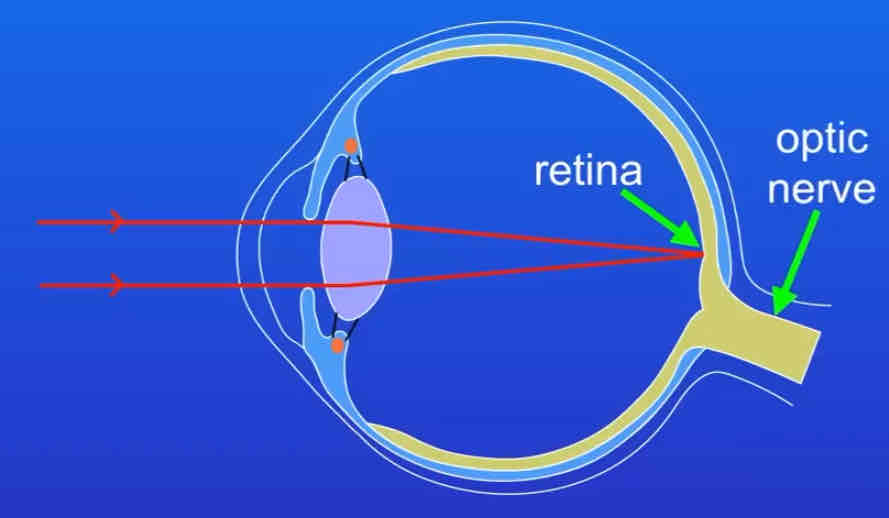
ᵀ What is the function of the optic nerve?
The receptor cells in the retina send electrical impulses down the optic nerve to the brain.
ᵀ Where in the eye is the sclera?
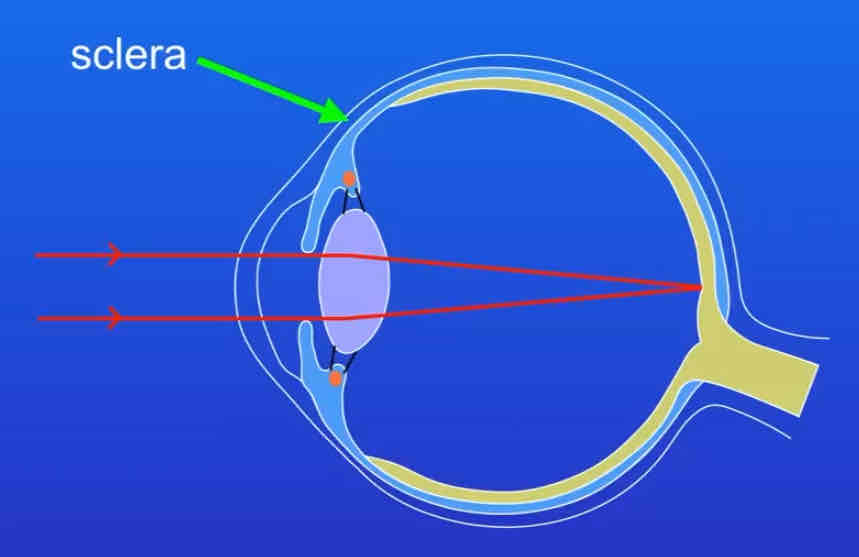
ᵀ What is the function of the sclera?
It protects the eye
ᵀ Where in the eye is the cornea?
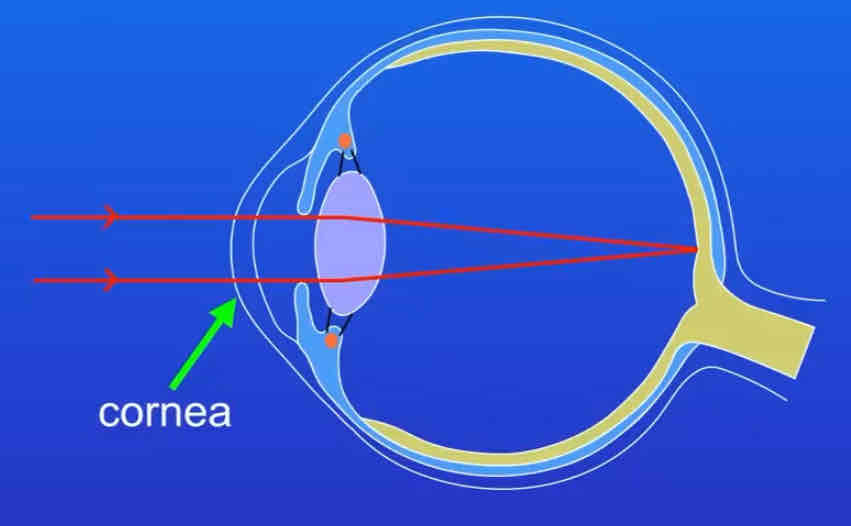
ᵀ What is the function of the cornea?
It starts the focusing of the light rays
ᵀ Where in the eye is the iris?
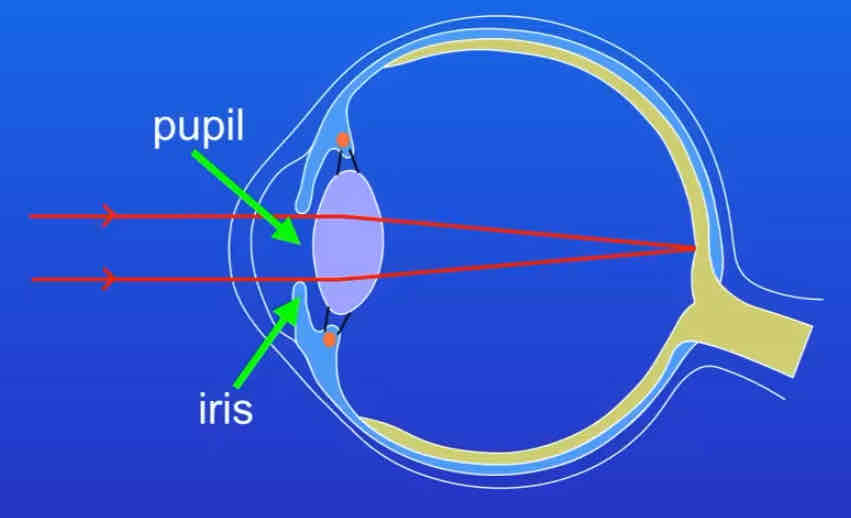
ᵀ What is the function of the iris?
It controls the size of the pupil
ᵀ Where in the eye are the ciliary muscles and the suspensory ligaments?
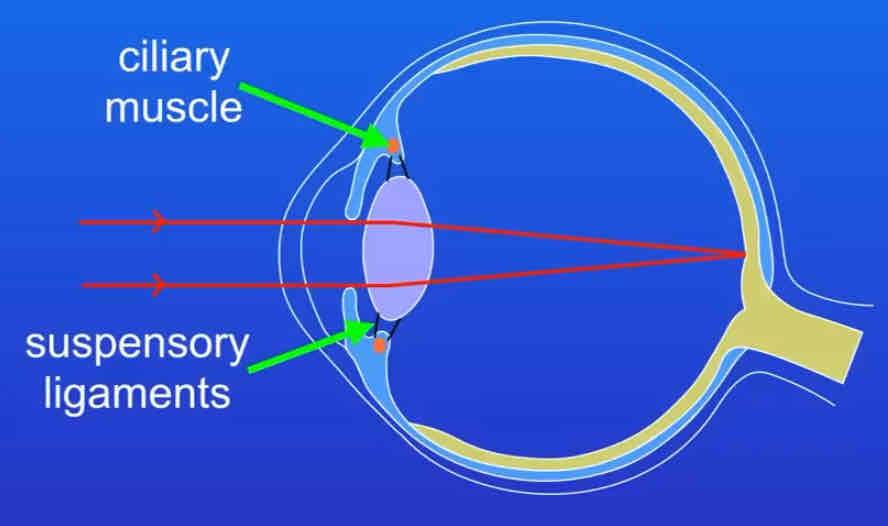
ᵀ What is the function of the ciliary muscles and suspensory ligaments?
They work with the lens to focus on distant or near objects
ᵀ What is accommodation?
The process of changing the shape of the lens to focus on near or distant objects
ᵀ How does the eye focus on a near object?
The ciliary muscles contract and the suspensory ligaments loosen. The lens is then thicker and refracts light rays strongly.
ᵀ How does the eye focus on a distant object?
The ciliary muscles relax and the suspensory ligaments are pulled tight. The lens is then pulled thin and only slightly refracts light rays.
ᵀ What are two common defects of the eyes?
Myopia (short sightedness) and hyperopia (long sightedness)
ᵀ How are myopia and hyperopia treated?
Generally these defects are treated with spectacle lenses which refract the light rays so that they do focus on the retina. New technologies now include hard and soft contact lenses, laser surgery to change the shape of the cornea and a replacement lens in the eye.
ᵀ Where is body temperature monitored and controlled?
The thermoregulatory centre in the brain
ᵀ What parts of the body have temperature receptors?
The thermoregulatory centre contains receptors sensitive to the temperature of the blood. The skin contains temperature receptors and sends nervous impulses to the thermoregulatory centre.
ᵀ What happens if the body temperature is too high?
Blood vessels dilate (vasodilation) and sweat is produced from the skin glands. Both these mechanisms cause a transfer of energy from the skin to the environment.
ᵀ What happens if the body temperature is too low?
Blood vessels constrict (vasoconstriction), sweating stops and skeletal muscles contract (shiver).
ᵀᴴ How does vasodilation lower body temperature?
Because the blood vessels have dilated, more blood flows through the capillaries. Heat can now transfer out of the blood, so the body temperature returns to its normal level.
ᵀᴴ How does sweating lower body temperature?
When the sweat evaporates, it takes energy from the body, cooling the body down.
ᵀᴴ How does vasoconstriction raise body temperature?
Because the blood vessels have constricted, less blood flows through the capillaries and less heat is lost from the body.
ᵀᴴ How does shivering raise body temperature?
To generate energy for muscle contraction, the muscle cells increase their rate of respiration. This releases heat, which warms the body.
What does the endocrine system do?
The endocrine system is composed of glands which secrete chemicals called hormones directly into the bloodstream. The bloodstream carries the hormone to a target organ where it produces an effect.
What is the endocrine system like, compared to the nervous system?
In the endocrine system, the effects are slower but act for longer
What does the pituitary gland do?
The pituitary gland in the brain is a ‘master gland’ which secretes several hormones into the blood in response to body conditions. These hormones in turn act on other glands to stimulate other hormones to be released to bring about effects.
Where in the human body is the pituitary gland?
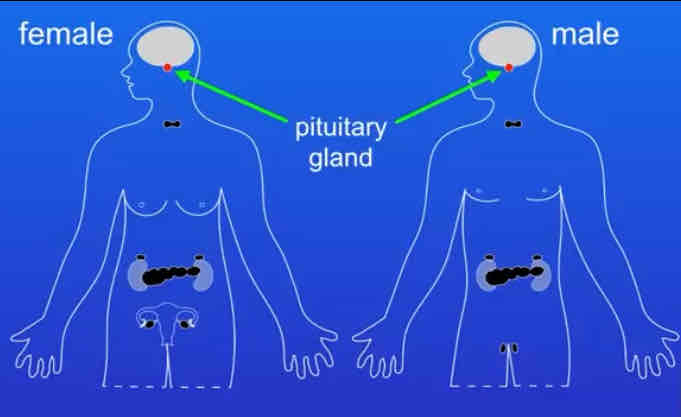
Where in the human body is the pancreas?
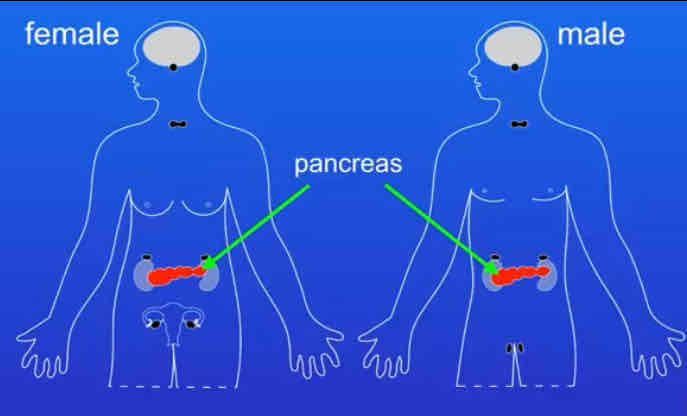
Where in the human body is the thyroid gland?
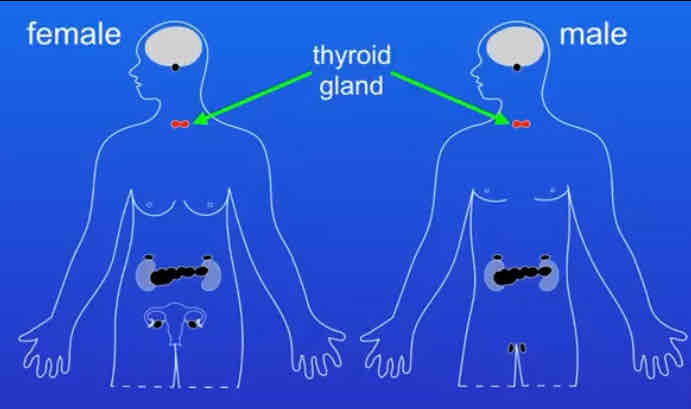
Where in the human body is the adrenal gland?
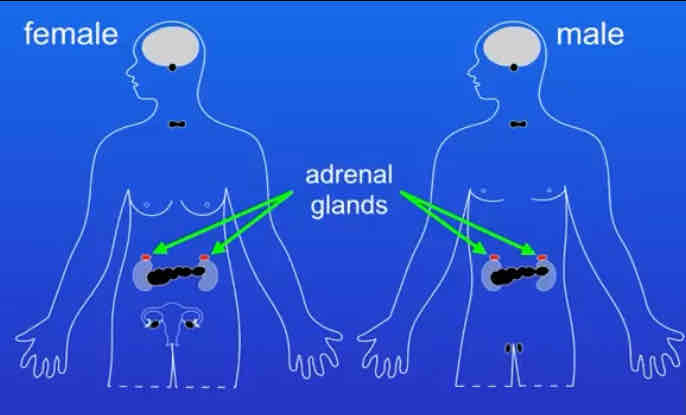
Where in the human body are the ovaries?
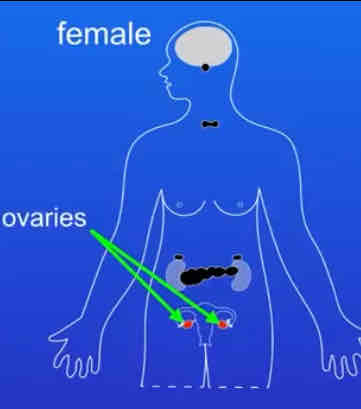
Where in the human body are the testes?
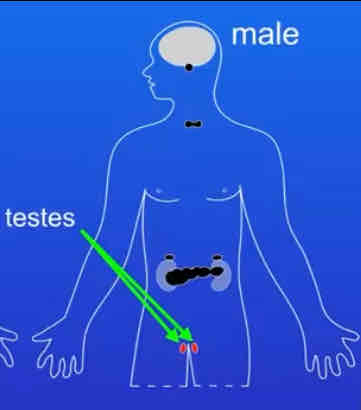
Where is blood glucose concentration monitored and controlled?
The pancreas
What happens if the blood glucose concentration is too high?
The pancreas produces the hormone insulin that causes glucose to move from the blood into the cells. In liver and muscle cells excess glucose is converted to glycogen for storage.
What is type 1 diabetes?
A disorder in which the pancreas fails to produce sufficient insulin. It is characterised by uncontrolled high blood glucose levels.
How is type 1 diabetes normally treated?
Insulin injections
What happens in type 2 diabetes?
The body cells no longer respond to insulin produced by the pancreas
What are common treatments for type 2 diabetes?
A carbohydrate controlled diet and an exercise regime
What is a risk factor for type 2 diabetes?
Obesity
ᴴ What happens if the blood glucose concentration is too low?
The pancreas produces the hormone glucagon that causes glycogen to be converted into glucose and released into the blood
ᴴ Explain how glucagon interacts with insulin to control blood glucose levels in the body.
Over the course of the day, the blood glucose concentration rises slightly and falls slightly. This is because the blood glucose concentration is controlled by a balance between insulin and glucagon. If the glucose concentration rises then the pancreas releases insulin and this causes the glucose concentration to fall. However, when the glucose concentration falls to a certain level, the pancreas releases glucagon, which causes the glucose concentration to rise again. Because insulin and glucagon have opposite effects on the blood glucose concentration, they form a negative feedback cycle.
ᵀ Explain the effect on cells of osmotic changes in body fluids.
If the blood becomes too dilute, water moves into cells by osmosis. If the blood becomes too concentrated, water moves out of cells by osmosis. If body cells lose or gain too much water by osmosis they do not function efficiently.
ᵀ How are water, ions and urea lost by the lungs, skin and kidneys?
Water leaves the body via the lungs during exhalation.
Water, ions and urea are lost from the skin in sweat.
There is no control over water, ion or urea loss by the lungs or skin.
Excess water, ions and urea are removed via the kidneys in the urine.
ᵀᴴ How are excess amino acids excreted safely?
In the liver the amino acids are deaminated to form ammonia. Ammonia is toxic and so it is immediately converted to urea for safe excretion.
ᵀ How do the kidneys produce urine?
By filtration of the blood and selective reabsorption of useful substances such as glucose, some ions and water
ᵀᴴ What is the effect of ADH on the permeability of the kidney tubules?
ADH causes the kidney tubules to become more permeable to water
ᵀᴴ What does the body do if the blood is too concentrated?
ADH is released by the pituitary gland when the blood is too concentrated and it causes more water to be reabsorbed back into the blood from the kidney tubules. This is controlled by negative feedback.
ᵀ How can people who suffer from kidney failure be treated?
Organ transplant or kidney dialysis
ᵀ How does kidney dialysis work?
When a patient has kidney failure, their blood will contain a higher concentration of water, ions and urea than it should. In kidney dialysis, the patient’s blood passes over a semi-permeable membrane. This allows urea, ions and water throughout it, but it will not allow larger molecules such as proteins to pass through. Blood cells are also too large to pass through the membrane. On the other side of the membrane, there is dialysis fluid. The dialysis fluid contains the normal concentrations of water and ions, but it does not contain any urea. There is a concentration gradient for urea, so the urea diffuses from the blood into the dialysis fluid. The dialysis fluid is constantly refreshed. This ensures that there is always a large concentration gradient for urea. The dialysis fluid also contains the normal concentrations of water and ions. This means that some of the water and some of the ions will diffuse from the blood into the dialysis fluid. Because of this, the concentrations of water and ions in the patient’s blood will return to normal.
What do reproductive hormones do during puberty?
They cause secondary sex characteristics to develop
What is oestrogen?
The main female reproductive hormone produced in the ovary
What is ovulation?
At puberty eggs begin to mature, and one is released approximately every 28 days
What is testosterone?
Testosterone is the main male reproductive hormone produced by the testes. It stimulates sperm production.
What does follicle stimulating hormone (FSH) do?
It causes maturation of an egg in the ovary
What does luteinising hormone (LH) do?
It stimulates the release of the egg
What do oestrogen and progesterone do?
They are involved in maintaining the uterus lining
ᴴ How do FSH, oestrogen, LH and progesterone interact to control the menstrual cycle?
In the first stage, FSH is released by the pituitary gland. FSH travels in the blood to the ovaries where it causes an egg to mature. At the same time, FSH triggers the ovaries to make oestrogen. Oestrogen causes the lining of the uterus to become thick. Oestrogen also stops the pituitary gland from releasing any more FSH. Instead, the pituitary gland now releases LH. LH triggers ovulation - the mature egg is released. Once the ovary has released its egg, the ovary produces the hormone progesterone. Progesterone has two effects: it stops the pituitary gland from releasing FSH and LH, to prevent any more eggs from maturing or being released, and it keeps the lining of the uterus thick in case a fertilised egg implants. If fertilisation does not take place, the level of progesterone falls. The uterus lining and the egg are released and the woman has a period.
What methods of contraception are there?
Oral contraceptives that contain hormones to inhibit FSH production so that no eggs mature
Injection, implant or skin patch of slow release progesterone to inhibit the maturation and release of eggs for a number of months or years
Barrier methods such as condoms and diaphragms which prevent the sperm reaching an egg
Intrauterine devices which prevent the implantation of an embryo or release a hormone
Spermicidal agents which kill or disable sperm
Abstaining from intercourse when an egg may be in the oviduct
Surgical methods of male and female sterilisation
What are the advantages and disadvantages of oral contraceptives?
They are highly effective if taken correctly. However, they must be taken every day. If a woman forgets to take it, there is a risk of pregnancy. Certain contraceptive pills also have a risk of side effects. These include an increased risk of breast cancer or blood clots. However, these risks are small. Also, they do not protect against sexually transmitted infections (STIs).
What are the advantages and disadvantages of injections, implants or skin patches of progesterone (as contraception)?
They are more convenient than taking a daily pill. However, they can have side effects. Also, they do not protect against sexually transmitted infections (STIs).
What are the advantages and disadvantages of barrier methods of contraception?
Barrier methods are an effective form of contraception if they are used correctly. Because they do not use hormones, they do not have side effects. Condoms can also reduce the risk of STIs. However, one disadvantage of condoms is that they can break or slip off.
What are the advantages and disadvantages of intrauterine devices (for contraception)?
An IUD is highly effective and can prevent pregnancy for up to ten years. IUDs also have very few side effects. However, an IUD does not protect against sexually transmitted infections.
What are the advantages and disadvantages of surgical methods of contraception?
Sterilisation is highly effective. However, it is very difficult to reverse, so a person has to be certain that they will never want children before going ahead. Surgical forms of contraception do not protect against STIs.
What are the advantages and disadvantages of abstaining from sexual intercourse (as contraception)?
It is very hard to tell when a woman has ovulated. This makes natural forms of contraception difficult. This method of contraception does not protect against STIs.
ᴴ What does a ‘fertility drug’ do?
FSH and LH are given to a woman. This is called a ‘fertility drug’. This causes the woman to ovulate more than usual. This increases her chance of becoming pregnant through sexual intercourse.
ᴴ What happens in In Vitro Fertilisation (IVF) treatment?
IVF involves giving a mother FSH and LH to stimulate the maturation of several eggs. The eggs are collected from the mother and fertilised by sperm from the father in the laboratory. The fertilised eggs develop into embryos. At the stage when they are tiny balls of cells, one or two embryos are inserted into the mother’s uterus (womb).
ᴴ What are the advantages and disadvantages of fertility treatment?
Although fertility treatment gives a woman the chance to have a baby of her own: it is very emotionally and physically stressful, the success rates are not high and it can lead to multiple births which are a risk to both the babies and the mother.
ᴴ What does adrenaline do?
Adrenaline is produced by the adrenal glands in times of fear or stress. It increases the heart rate and boosts the delivery of oxygen and glucose to the brain and muscles, preparing the body for ‘flight or fight’.
ᴴ What does thyroxine do?
Thyroxine from the thyroid gland stimulates the basal metabolic rate. It plays an important role in growth and development.
ᴴ What are thyroxine levels controlled by?
Negative feedback
ᵀ Why do plants produce hormones?
To coordinate and control growth and responses to light (phototropism) and gravity (gravitropism or geotropism)
ᵀ What do unequal distributions of auxin cause?
Unequal growth rates in plant roots and shoots
ᵀᴴ Where are gibberellins important?
Initiating seed germination
ᵀᴴ What does ethene control?
Cell division and ripening of fruits
ᵀ Describe how to investigate the effect of light on the growth of newly germinated seedlings. Explain typical results.
1. Place cotton wool in three Petri dishes, and soak them with equal volumes of water.
2. Place ten seeds in each dish.
3. Leave the dishes in a warm place and allow the seeds to germinate.
4. Water the seeds every day with the same volume of water. After a few days, the seeds will germinate.
5. Make sure that the three dishes have the same number of seedlings by removing seedlings where necessary.
6. Use a ruler to measure the height of each seedling. Hold the stems to make sure they are straight. Be careful not to damage the seedlings.
7. Place one dish in full sunlight (e.g. a very bright windowsill), place one in partial light (e.g. at the back of a lab), and place one in darkness (e.g. in a cupboard).
8. Measure the height of each seedling each day for at least five consecutive days, and record the results in a table. When the experiment is finished, calculate a mean seedling height for each day.
9. Draw diagrams to show the effects of different light intensities on the seedlings.
The height of the seedlings is similar for both full sunlight and partial light. That is because chlorophyll is very efficient at absorbing light energy, so plants do not need full sunlight to grow. The seedlings have grown towards the light source. This is due to phototropism: auxin concentrates on the side of the seedling furthest from the light and causes that side to grow faster.
The seedlings in the dark have grown the longest. That is because seeds usually germinate underground and they grow rapidly to reach the light. If we keep seedlings in the dark, then they continue to grow rapidly, trying to reach light. The leaves are small and yellow. That is because once the seedlings have used all their energy stores, they cannot carry out photosynthesis in the dark.
ᵀ Describe how to investigate the effect of gravity on the growth of newly germinated seedlings. Explain typical results.
1. Place cotton wool in a Petri dish and soak it with water.
2. Place a fixed number of seeds in the dish.
3. Leave the dish in a warm place and allow the seeds to germinate.
4. Water the seeds every day with the same volume of water. After a few days, the seeds will germinate.
5. Remove any ungerminated seedlings from the Petri dish.
6. Place a dish of seedlings on its side in the dark.
The shoots have grown upwards, against the direction of gravity, and the roots have grown downwards towards the direction of gravity. Auxin inhibits cell growth in roots. Gravity causes auxin to build up on the lower side of the root. This now grows more slowly than the upper side and this makes the root grow in the direction of gravity.
ᵀᴴ Where are plant growth hormones used?
In agriculture and horticulture
ᵀᴴ Where and why is ethene used?
In the food industry, to control ripening of fruit during storage and transport